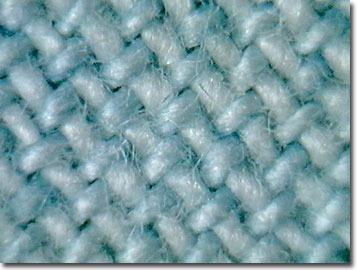Reflected Light Digital Image Gallery
Blue Cotton Denim
The fabric that helped Bavarian immigrant Levi Strauss launch an empire in 1873, blue cotton denim, is most famous as the material from which blue jeans are constructed. Denim, actually historically distinct from jean cloth, is a durable fabric that was originally imported from England and known by its weavings as a coarse cotton drilling, which was suitable in wear and comfort for work clothes.

In the mid-1800s mechanics and painters wore overalls made of blue denim, while working men in general, including manual laborers, wore more tailored trousers made of jean fabric. The origins of the word "denim" are a bit confused, but may date to an English corruption of the French for a similar twill-weave fabric made of silk and wool referred to as "serge de Nīmes". "Jean" shows its origins in Genoa, Italy during the sixteenth century when large quantities of the cotton, linen, and wool blend were imported to England. By the eighteenth century, jean cloth made completely of cotton was manufactured in Lancashire. Although denim was more expensive than jean, it rose in popularity because of its strength and comfort. While denim is woven from one colored thread and one white thread, jean fabric was woven of two threads of the same color.
By the late eighteenth century, American textile mills produced their own denim fabric and in 1789, President George Washington toured the first mill in Massachusetts to weave both denim and jean. With the boom of cotton plantations in America's South based on slave labor and maritime trade, jean cloth was made entirely of cotton. The blue dye, extracted from indigo plants, was added and the color became a familiar one for workwear. During the Gold Rush in San Francisco in 1873, Levi Strauss introduced the first blue cotton denim workwear featuring metal rivets for added strength. In 1964, a pair of Levi jeans entered the permanent collections of the Smithsonian Institution in Washington, D.C., and through countless cowboy Westerns and James Dean's Rebel Without A Cause, blue jeans and blue cotton denim caught and held the attention of the youth of the world, in spite of being one of the world's oldest fabrics.
Contributing Authors
Cynthia D. Kelly, Thomas J. Fellers and Michael W. Davidson - National High Magnetic Field Laboratory, 1800 East Paul Dirac Dr., The Florida State University, Tallahassee, Florida, 32310.
BACK TO THE REFLECTED LIGHT IMAGE GALLERY
BACK TO THE DIGITAL IMAGE GALLERIES
Questions or comments? Send us an email.
© 1995-2022 by Michael W. Davidson and The Florida State University. All Rights Reserved. No images, graphics, software, scripts, or applets may be reproduced or used in any manner without permission from the copyright holders. Use of this website means you agree to all of the Legal Terms and Conditions set forth by the owners.
This website is maintained by our
Graphics & Web Programming Team
in collaboration with Optical Microscopy at the
National High Magnetic Field Laboratory.
Last Modification Friday, Nov 13, 2015 at 02:19 PM
Access Count Since September 17, 2002: 16051
Visit the website of our partner in introductory microscopy education:
|
|
